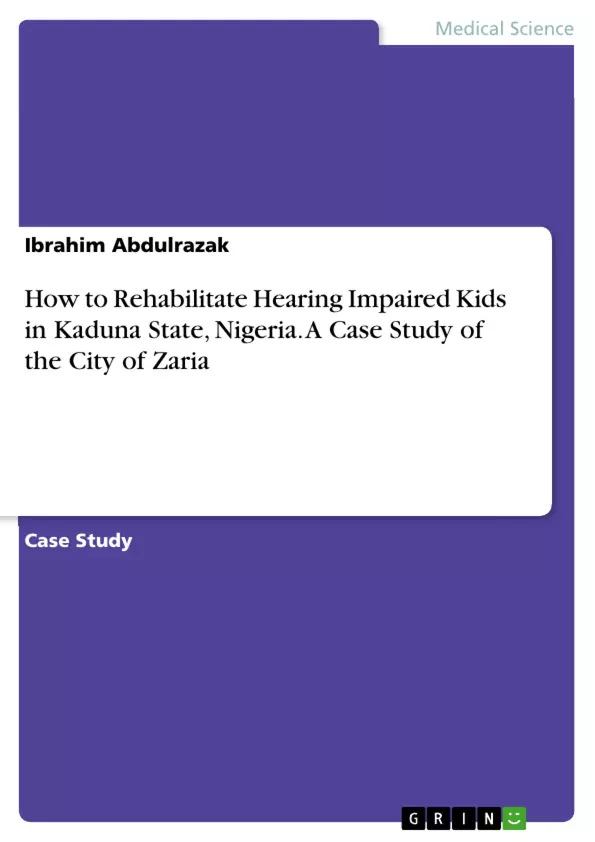This study focuses on a survey of the process of rehabilitating hearing impaired students of agricultural schools inthe city of Zaria, Kaduna State, Nigeria.
A case study of several agriculatural schools in Zaria was made. The sample for the study consisted of 50 students. Ten students were randomly selected from the senior secondary classes in the five selected secondary schools in the study area. The selection was done through random sampling techniques. The questionnaire entitle “students personality and their academic performance in agricultural science in secondary schools” was the main instrument for data collection.
The result from the analyzed data indicatesthat student’s self-concept, motivation, attitude and anxiety are significantly related to academic performance in agricultural science. In the light of the above findings, it is concluded that the personality of students have influence on their academic performance in agricultural. It is recommended among others that students should be encouraged to develop positive self-concept, be self-motivated and develop positive attitudes toward the study of agricultural science if they intend to ensure a high academic performance in the subject.
Inhaltsverzeichnis (Table of Contents)
- CHAPTER ONE
- 1.0 Introduction
- 1.1 Background of the study
- 1.2 Statement of the Problem
- 1.3 Purpose of the Study
- 1.4 Research Questions
- 1.5 Research Hypotheses
- 1.6 Significance of the Study
- 1.7 Scope and Delimitation of the Study
- CHAPTER TWO
- 2.0 Introduction
- 2.1 Concept Rehabilitation
- 2.2 Definition of Hearing Impairment?
- 2.3 Hearing Impairment
- 2.4 Causes of Hearing Impairment
- 2.5 Identification and Assessment of Persons with Hearing Impairment
- 2.6 Vocational Rehabilitation for the Hearing Impaired Children
- 2.7 Purpose of Vocational Rehabilitation of Persons with Hearing Impairment
- 2.8 The rehabilitation process for Exceptional persons
- 2.9 Classification of Rehabilitative Service and Beneficiaries
- 2.10 Basic Steps in Rehabilitation of Person with Hearing Impairment
- 2.11 Steps in process of rehabilitation of persons with Hearing Impairment
- 2.12 Outlets of Rehabilitation Services
- 2.13 Summary
- CHAPTER THREE
- 3.0 Introduction
- 3.1 Research Design
- 3.2 Population of the Study
- 3.3 Sample and Sampling Techniques-
- 3.4 Instruments for Data Collection
- 3.5 Reliability/Validity of Instrument-
- 3.6 Procedure for Data Collection
- 3.7 Method of Data Analysis
- CHAPTER FOUR
- 4.0 Introduction
- CHAPTER FIVE
- 5.1 Introduction
- 5.2 Summary and Findings
Zielsetzung und Themenschwerpunkte (Objectives and Key Themes)
This study aims to survey the process of rehabilitating hearing-impaired individuals in Kaduna State, focusing on the Zaria Local Government Area. The research investigates the relationship between student personality traits and academic performance in agricultural science.
- The impact of personality on academic performance in agricultural science.
- The process of rehabilitating hearing-impaired individuals.
- Factors influencing the success of rehabilitation programs.
- The role of personality traits in student success.
- The importance of positive self-concept, motivation, and attitude in academic performance.
Zusammenfassung der Kapitel (Chapter Summaries)
Chapter One provides an introduction to the study, outlining the background, statement of the problem, purpose, research questions, hypotheses, significance, and scope of the research. It emphasizes the importance of hearing and how hearing impairment can impact communication and learning.
Chapter Two delves into the existing literature related to the topic. It defines hearing impairment, explores its causes, and discusses the identification and assessment of individuals with hearing loss. The chapter also focuses on the concept of rehabilitation, its purpose, and the process of rehabilitating exceptional individuals, including steps and service outlets.
Chapter Three outlines the methodology employed in the study. It describes the research design, population, sample, sampling techniques, data collection instruments, reliability and validity of instruments, data collection procedures, and data analysis methods.
Chapter Four analyzes and interprets the data gathered during the research.
Schlüsselwörter (Keywords)
Hearing Impairment, Rehabilitation, Personality, Academic Performance, Agricultural Science, Self-Concept, Motivation, Attitude, Kaduna State, Zaria Local Government Area.
- Arbeit zitieren
- Ibrahim Abdulrazak (Autor:in), 2016, How to Rehabilitate Hearing Impaired Kids in Kaduna State, Nigeria. A Case Study of the City of Zaria, München, GRIN Verlag, https://www.grin.com/document/500287



